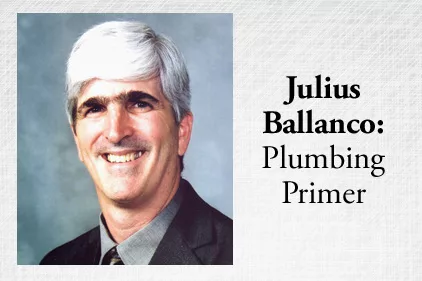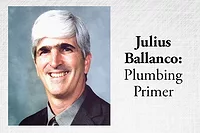Value engineering: Investigate changes of plumbing system without decreasing quality

The term “value engineering” has been a major part of the plumbing profession for a number of years. Plumbing contractors like the term as a means of cutting construction costs while increasing profits. There is nothing wrong with trying to increase profits. That is what it is all about in the contracting business.
On the other hand, many engineers hate the term value engineering. Notice how I said many. Some engineers thrive on value engineering and offer this to their clients, many of whom are contractors. The others are normally the owners.
Unfortunately, the term value engineering has come to mean “make it cheap.” The original concept had merit but more and more it has become “de-value” engineering.
Let me give some examples of original value engineering that still make sense. Assume the engineer decided to individually vent every fixture in 500 bathrooms of a new hotel. You look at the project and realize you could wet vent every bathroom group and save $250 per room in piping costs. You then offer the owner a savings of $100 per room, or $50,000. This is a great deal for the owner. They lose nothing in the performance of the plumbing system and you saved them $50,000.
Realize that nobody other than you needs to know you increased your profit on the project by $75,000. That is the benefit of good value engineering. You may be asking what is the downside. When there is a change in piping arrangement resulting in a system that works the same, nothing. The problem is when you change a product because one manufacturer’s price is lower than another’s. That is where you can have serious problems.
Assume an engineer specified a component, such as a high-end control valve, in stainless steel. You get prices from the manufacturers’ representative and realize the same valve in cast iron is $500 less. You have 50 of these valves to install. That means a savings of $25,000. You, and maybe even the manufacturers’ representative, assume the engineer was just nuts for specifying such a high-end valve. So you install the lower-cost valves, save $25,000 and assume all is good.
What you didn’t realize is the engineer did a thorough analysis of the water and determined the cast-iron valve would not last as long as the stainless-steel valve. When the valves start to fail in five years, what do you think happens? If you guessed lawsuit, you are correct. Your value engineering just became expensive engineering.
You might immediately assume it is not good to ever buy a lower-cost product, fixture or material. No, that is not true either. What you really need to do is properly investigate every aspect of value engineering.
Some contractors value engineer by just buying the cheapest plumbing fixtures on the market, no matter what the engineer specifies. But if those fixtures are of a lower quality that doesn’t last, you have provided no value to the customer.
Making it work for you
On the other hand, I recall a contractor who changed models of water closets on all residential projects. The water closet he installed looked as nice as the water closet that was specified. Both were made in the United States, so that wasn’t an issue. As it turns out, the model he installed had a better flushing performance than the higher-cost models that were specified. Finally, the savings for each water closet was approximately $300. The difference was the name you looked at when you used the fixture.
This contractor never had any problems. As to why there was such a big difference in price, you’ll have to ask the manufacturers. But such a switch in fixtures did provide value to the customer, saved him money and made the plumbing contractor a higher profit.
Another common switch, occurring within the last 15 years, has been the joining of copper tube. Assume the engineer specifies copper with solder joints. Maybe the engineer even went overboard by specifying 95-5 solder. To me, that is the toughest solder to make a joint correctly. Sorry, it is just a bear to work with.
The plumbing contractor offers a savings of 10% on the copper installation by allowing a switch to press-connect fittings. Press-connect fittings take a fraction of the time to join compared to soldering. However, they cost more to buy. In the long run, you figure there is considerable savings on the project.
The installation of press-connect fittings is another example of value being added to the customer. You save him money, plus you have an easier time installing the project. Some contractors consider press-connect to be better than soldering, but I won’t enter into that battle. The bottom line is they still have a copper installation, they still have water running through the tubing and they saved money.
These are just a couple examples of plumbing contractors thoroughly analyzing a change to provide value engineering. They truly are providing value, and they are engineering by investigating all aspects of the installation.
Value engineering is not going into the supply house and finding out what is cheaper to buy. Value engineering is investigating possible changes without decreasing the quality of the plumbing system. The last thing you need are future lawsuits because you decided to be cheap. Cheap becomes expensive real fast when lawyers are involved.
It is time to return the term value engineering to its original intent — providing the same or better value in a plumbing installation at a savings to the customer. Don’t just make it cheap.
It is time to perform another type of value engineering. Look for the best gift at the best price to bring joy to your loved ones this holiday season. Have a Merry Christmas, Happy Chanukah, Happy Holidays, and a happy and profitable New Year.
HELPFUL LINKS:
Looking for a reprint of this article?
From high-res PDFs to custom plaques, order your copy today!






